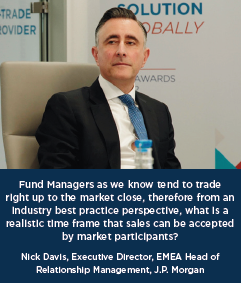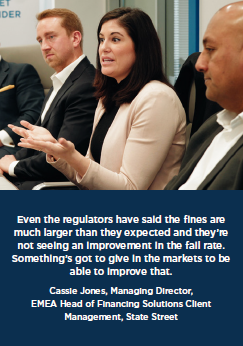EU Beneficial Owners Roundtable 2023: Regulation and risk mitigation

Regulation and risk mitigation
The 2023 EU Beneficial Owners’ Roundtable was moderated by Andy Dyson, the Chief Executive of ISLA with EquiLend as the lead sponsor. The roundtable was held in late March with a panel of industry experts discussing topics from the data, ESG, collateral and the change from 2022 to 2023.
A portion of the 2023 EU Beneficial Owners Roundtable is available in the video above. See below for a transcript of the highlights.
Andy Dyson, Chief Executive Officer, ISLA: One of the things that I see and I think we’ve got to recognise is that one of the unintended consequences of the regulatory agenda over the last 10 years is how business has flowed into larger names. What are you seeing from a performance and opportunity perspective?
Olivier Zemb, Head of Equity Finance and Collateral Trading, Caceis Bank: I agree with everyone else’s comments but I will be a bit cautious when it comes to US equities. As Maurice said, revenues are highly concentrated on a few names. This could then have a significant impact on programmes’ performances.
Other than that, I think it’s going to be a very good year, especially on the govies side. Regarding credit, 2023 should also be an excellent year for corporate and convertible bonds, probably even better than 2022 which was the best year ever in terms of returns, as commercial property and the retail sector remain sought after.
Finally, revenues generated on ETFs should keep on increasing. I think the correlation between stocks, industries and countries is higher now than before.
Nick Davis, Executive Director, EMEA Head of Relationship Management, J.P. Morgan: We have certainly seen a convergence for both the client and trading businesses. The occurring theme is maximising performance, capital, and efficiency which includes, but not limited to, the lending of assets while mobilising collateral.
Mobilisation has been key to help facilitate the financing of both long and short cash trades. Risk taking is also being reviewed by clients following a shift in some programs out of operations and into a Treasury function.
Clients see additional value in moving away from the traditional indemnified program and approving more non vanilla type trades, esoteric forms of collateral or increasing general utilisation in specific markets. These examples would see additional value being added to their lending program.
Andy Dyson: I think a couple of you mentioned the idea of, is it collateral transformation, or is it the provision of liquidity? Other drivers there were the arrival of margin rules for uncleared derivatives, and as they’ve gone down into the lower waves of those investment management clients. Surprise, surprise, many of those clients don’t have a trading desk to actually manage their own liquidity.
Stephen Kiely, Head of the BNY Mellon Securities Finance Client Relationship Management and Business Development Teams in EMEA: We’re seeing clients starting to put their treasury financing and maybe their securities lending together to realise the efficiencies within their own organisations. I think that’s changing the dynamic somewhat, and we’re seeing clients tweak their programs here and there.
Nick Davis: It’s about managing an efficient book. Should assets be better utilised under a lending transaction or through synthetics?
Andy Dyson: The point you may say is spot on and it is one of the conversations we’re having a lot of is Total Return Swaps. What does that look like? How is that business evolving? It’s always been a part of the broker-to-broker world and it’s always been a feature of certain very large clients. What should we expect to see from a regulatory perspective?
Nick Davis: There are two key regulatory points I would like to raise, US T+1, and 10c-1. Addressing US 
Fund Managers as we know tend to trade right up to the market close, therefore from an industry best practice perspective, what is a realistic time frame that sales can be accepted by market participants?
The second regulation is 10c-1, and I see two main challenges. First point is the reporting every 15 minutes. The current model certainly doesn’t allow for a 15-minute turnaround.
The second point is around reporting from an inventory perspective. The regulation asks that you report on the total inventory. Will beneficial owners want to disclose their total inventory? In addition, some beneficial owners may want to hold back a certain percentage of their lendable. Therefore, will that disrupt liquidity? Could we see incorrect data being supplied? There are still challenges that need to be addressed.
Andy Dyson: I think you’re right that one of the challenges with increasing your settlement rate or reducing your time is that if you’ve got endemic issues embedded in your market, its just going to make things worse, certainly in the short term.
Cassie Jones, Managing Director, EMEA Head of Financing Solutions Client Management, State 
Ernst Dolce, CEO & Co-Founder, Biben Capital Markets: The market should not push for higher fines or encourage the regulator to do so! The penalty is computed as a basis point times a notional, depending on the size of the trade - the fines are already large enough. For some markets, such as credit and emerging markets, increasing the size of the penalty could kill the liquidity. Therefore, we all need to be careful.
Andy Dyson: We had a conversation at the Bank of England somebody said that when you look at going to the insurance market to buy an indemnity, it’s very expensive. So, my comment was, it’s probably the right price and what you’ve been charging for the last 30 years has been the wrong price. I don’t know if anybody agrees.
Found this useful?
Take a complimentary trial of the FOW Marketing Intelligence Platform – the comprehensive source of news and analysis across the buy- and sell- side.
Gain access to:
- A single source of in-depth news, insight and analysis across Asset Management, Securities Finance, Custody, Fund Services and Derivatives
- Our interactive database, optimized to enable you to summarise data and build graphs outlining market activity
- Exclusive whitepapers, supplements and industry analysis curated and published by Futures & Options World
- Breaking news, daily and weekly alerts on the markets most relevant to you



